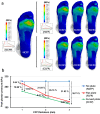Curved carbon-plated shoe may further reduce forefoot loads compared to flat plate during running
- PMID: 38851842
- PMCID: PMC11162459
- DOI: 10.1038/s41598-024-64177-3
Curved carbon-plated shoe may further reduce forefoot loads compared to flat plate during running
Abstract
Using a curved carbon-fiber plate (CFP) in running shoes may offer notable performance benefit over flat plates, yet there is a lack of research exploring the influence of CFP geometry on internal foot loading during running. The objective of this study was to investigate the effects of CFP mechanical characteristics on forefoot biomechanics in terms of plantar pressure, bone stress distribution, and contact force transmission during a simulated impact peak moment in forefoot strike running. We employed a finite element model of the foot-shoe system, wherein various CFP configurations, including three stiffnesses (stiff, stiffer, and stiffest) and two shapes (flat plate (FCFP) and curved plate (CCFP)), were integrated into the shoe sole. Comparing the shoes with no CFP (NCFP) to those with CFP, we consistently observed a reduction in peak forefoot plantar pressure with increasing CFP stiffness. This decrease in pressure was even more notable in a CCFP demonstrating a further reduction in peak pressure ranging from 5.51 to 12.62%, compared to FCFP models. Both FCFP and CCFP designs had a negligible impact on reducing the maximum stress experienced by the 2nd and 3rd metatarsals. However, they greatly influenced the stress distribution in other metatarsal bones. These CFP designs seem to optimize the load transfer pathway, enabling a more uniform force transmission by mainly reducing contact force on the medial columns (the first three rays, measuring 0.333 times body weight for FCFP and 0.335 for CCFP in stiffest condition, compared to 0.373 in NCFP). We concluded that employing a curved CFP in running shoes could be more beneficial from an injury prevention perspective by inducing less peak pressure under the metatarsal heads while not worsening their stress state compared to flat plates.
© 2024. The Author(s).
Conflict of interest statement
The authors declare no competing interests.
Figures



Similar articles
-
The influence of running shoe with different carbon-fiber plate designs on internal foot mechanics: A pilot computational analysis.J Biomech. 2023 May;153:111597. doi: 10.1016/j.jbiomech.2023.111597. Epub 2023 Apr 25. J Biomech. 2023. PMID: 37126883
-
The effect of eliminating leg length difference on plantar foot pressure distribution in patients wearing forefoot offloading shoe.Foot (Edinb). 2017 Dec;33:39-43. doi: 10.1016/j.foot.2017.10.003. Epub 2017 Oct 24. Foot (Edinb). 2017. PMID: 29126041
-
The effect of foot orthoses with forefoot cushioning or metatarsal pad on forefoot peak plantar pressure in running.J Foot Ankle Res. 2016 Nov 16;9:44. doi: 10.1186/s13047-016-0176-z. eCollection 2016. J Foot Ankle Res. 2016. PMID: 27891180 Free PMC article. Clinical Trial.
-
Systematic Review of the Role of Footwear Constructions in Running Biomechanics: Implications for Running-Related Injury and Performance.J Sports Sci Med. 2020 Feb 24;19(1):20-37. eCollection 2020 Mar. J Sports Sci Med. 2020. PMID: 32132824 Free PMC article.
-
Topical review: barefoot running.Foot Ankle Int. 2012 Sep;33(9):787-94. doi: 10.3113/FAI.2012.0787. Foot Ankle Int. 2012. PMID: 22995269 Review. No abstract available.
Cited by
-
The effects of different carbon-fiber plate shapes in shoes on lower limb biomechanics following running-induced fatigue.Front Bioeng Biotechnol. 2025 Feb 11;13:1539976. doi: 10.3389/fbioe.2025.1539976. eCollection 2025. Front Bioeng Biotechnol. 2025. PMID: 40008032 Free PMC article.
-
Biomechanical Effects of Sandal Strap Design on Gait Kinematics and Electromyographic Activation Patterns: A Speed-Dependent Analysis.Appl Bionics Biomech. 2025 Aug 7;2025:8802614. doi: 10.1155/abb/8802614. eCollection 2025. Appl Bionics Biomech. 2025. PMID: 40823061 Free PMC article.
-
Comparison of Landing Biomechanics in Male Amateur Basketball Players with and without Patellar Tendinopathy during Simulated Games.J Hum Kinet. 2025 Apr 30;96(Spec Issue):69-81. doi: 10.5114/jhk/201318. eCollection 2025 Feb. J Hum Kinet. 2025. PMID: 40453905 Free PMC article.
-
Biomechanical Study of Symmetric Bending and Lifting Behavior in Weightlifter with Lumbar L4-L5 Disc Herniation and Physiological Straightening Using Finite Element Simulation.Bioengineering (Basel). 2024 Aug 12;11(8):825. doi: 10.3390/bioengineering11080825. Bioengineering (Basel). 2024. PMID: 39199783 Free PMC article.
-
A Systematic Review of Finite Element Analysis in Running Footwear Biomechanics: Insights for Running-Related Musculoskeletal Injuries.J Sports Sci Med. 2025 Jun 1;24(2):370-387. doi: 10.52082/jssm.2025.370. eCollection 2025 Jun. J Sports Sci Med. 2025. PMID: 40469859 Free PMC article. Review.
References
-
- Nigg BM, et al. Highlighting the present state of biomechanics in shoe research (2000–2023) Footwear Sci. 2023;1:1–11.
MeSH terms
Substances
Grants and funding
- No.2023001/Research Academy of Medicine Combining Sports, Ningbo
- RGC #15211322/Research Grants Council
- JCYJ-20230807-14041-4029/Shenzhen Research Fund
- LR22A020002/Zhejiang Provincial Natural Science Foundation of China for Distinguished Young Scholars
- LTGY23H040003/Zhejiang Provincial Natural Science Foundation
- ZKKY2023001/Zhejiang Rehabilitation Medical Association Scientific Research Special Fund
- No.2022-F15/the Project of NINGBO Leading Medical &Health Discipline
- No.2022-F22/the Project of NINGBO Leading Medical &Health Discipline
- 2021S134/Public Welfare Science & Technology Project of Ningbo, China
- 2023C03197/Zhejiang Provincial Key Research and Development Program of China
- 2022J065/Ningbo Natural Science Foundation
- 20221JCGY010607/Ningbo Natural Science Foundation
LinkOut - more resources
Full Text Sources
Miscellaneous

